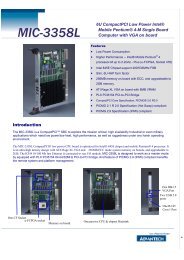industrial wireless book special edition - Networking ...
industrial wireless book special edition - Networking ...
industrial wireless book special edition - Networking ...
Create successful ePaper yourself
Turn your PDF publications into a flip-book with our unique Google optimized e-Paper software.
<strong>industrial</strong> <strong>wireless</strong><br />
Industrial <strong>wireless</strong> mesh networks<br />
can use IEEE802.11 standards<br />
There are many types mesh network technology which, taken together, can bring <strong>wireless</strong> connectivity to<br />
just about every conceivable <strong>industrial</strong> and process application. However, there is only one – IEEE802.11n –<br />
which truly meets the throughput and reliability demands of <strong>industrial</strong> automation, plus compatibility with<br />
enterprise IT standards says Advantech’s Alex Tsai and Kunhong Chen<br />
can provide interactive Scada and telemetry in<br />
places and over distances where it simply is<br />
not possible to get a wire or a signal in any<br />
other way. Likewise, WSN provides short range,<br />
low data rate connectivity with a power budget<br />
applicable to disposable batteries. However,<br />
only IEEE802.11n technology presently offers<br />
network-friendly IP routing and the sort of data<br />
rate applicable to <strong>industrial</strong> automation applications<br />
in a mesh topology format.<br />
Routing technique largely determines the<br />
characteristics of a mesh network. The routing<br />
function propagates the message by hopping<br />
the data from node to node along a path until<br />
the destination is reached. To ensure the availability<br />
of a path, a routing network must allow<br />
for a continuous connection and reconfiguration<br />
around broken or blocked paths through<br />
the use of self-healing algorithms. Self-healing<br />
capabilities enable routing based networks to<br />
operate when one node breaks down or a<br />
connection goes bad. As a result, the network<br />
is considered to be very reliable since there is<br />
often more than one path between a source<br />
and a destination in the network.<br />
ANY NETWORK which can function without preordered<br />
infrastructure may be described as<br />
having mesh topology. To meet this requirement,<br />
each node must not only capture and<br />
disseminate its own data, but also serve as a<br />
relay for other nodes. In other words, it must<br />
organise its own collaboration to propagate<br />
data across the network.<br />
The expression ‘mesh topology’ generally<br />
suggests MANET – as in Mobile Ad hoc Network<br />
– or WSN (as in Wireless Sensor Network), but<br />
it may also be applied to freely associated<br />
nodes operating with standards-based WLAN<br />
technologies such as IEEE802.11n. Of course<br />
networks constructed with GSM mobile or<br />
<strong>wireless</strong> sensor comms technology have<br />
incredibly useful properties. For instance GSM<br />
ARTWORK: FRANK OGDEN<br />
Mesh network parameters<br />
The three types of mesh with different uses are<br />
detailed here, all of which use the standardsbased<br />
features available in IEEE802.11n<br />
hardware. However, for the greatest flexibility<br />
a hybrid configuration is probably the most<br />
useful as will be shown.<br />
Client. Using one type of radio device e.g., an<br />
EKI-6340-3, as a client mesh provides peer-to-peer<br />
networks among client devices and the client nodes<br />
to perform routing and configuration functions.<br />
4<br />
Infrastructure<br />
<strong>industrial</strong> ethernet <strong>book</strong><br />
Hybrid<br />
sponsored by Advantech

















